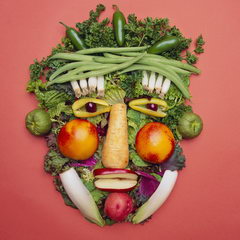This past summer, my mother and I studied with a personal trainer whom, despite the excellent ability to push her students, appeared to lack the ability to push herself. Her ill-toned appearance made me question her credibility and health aptitude. However, as my mother and I got to know our trainer, she eventually “out-ed” that she personally struggled with weight loss. Her days as an effortlessly slender ballerina with an incredibly fast metabolism were long gone. She informed us that, among other issues, she possessed a troublesome “thyroid” thereby making it quite challenging to lose weight. She believed she had a solution, which had worked wonders in the past. Her answer was an extreme manner of eating known as “the Raw Foods Diet.”
I found her take on the diet to be rather fascinating and, after sampling my very own $30 jar of raw, organic almond butter a couple of weeks ago, I decided to do some research of my own.
A food is pronounced “raw” if it is three things: organic, unprocessed, and uncooked. An organic food is one left untouched by pesticides, preservatives, irradiation and GMOs. An unprocessed food is served in its most natural state state possible, i.e. a carrot plucked straight from the ground or an apple picked directly from the tree and then purchased at a grocery store of course (get the idea?). An uncooked food is anything that has not been heated above 116 degrees Farenheit. At least 75% of foods within the Raw Foods lifestyle fit the aforementioned criteria. Thus, the diet is primarily composed of fresh fruits and vegetables, grains, legumes, nuts, seeds, beans, and sprouts.
The idea behind the diet is as follows:
Cooking food above 116 degrees Farenheit is said to kill enzymes. Enzymes help us digest food. It is true that the body can create its own enzymes to help break down what we intake, but the amount of which it can produce is limited. Furthermore, the enzymes that the body makes are weaker than those within living foods and in turn, food is not broken down and digested as well when cooked. The ultimate worst thing this can lead to is a build up of rotting foods in your intestines or worse, parasites living in the decaying build up in your gut.
In addition, cooking food past the raw foods temperature is said to obliterate most natural minerals and vitamins, essentially destroying the nutritional value at its finest. Not to mention, the PH level of the food is changed when heated and made to be more “acidic” as opposed to “alkaline.” The long story short repercussion of which is that an individual with a heavily weighted “acidic” diet is more prone to disease and the like. Raw Foodies also drink water that has been alkalinized. The scientific details of this process are rather difficult to explain but one can simply purchase an alkalizing device that will change regular water into ok filtered and favored beverage.
Last but not least, heating food is believed to destroy the “life” within. A cooked food is considered a “dead” food. Raw foodies assert that anything worth ingesting will be completely and utterly exterminated once heated at high temperatures. Living, raw foods supposedly give off energy that will in turn, provide the body with the most invigorating source of liveliness possible. Energized food is the fuel behind an energized consumer. This extreme style of consumption can even stimulate symptoms common to a “detoxification” cleanse such as cravings, nausea, and mild headaches. Thankfully though, these negative experiences usually only last for the first several days of the diet.
So why make the leap of food faith? The Best of Raw Foods.com sites energy, weight loss, skin clarity, memory enhancement, improved fertility, prevention or reverse severity of diabetes, and a more stabilized immune system as just a few of the diets benefits. (http://www.thebestofrawfood.com/raw-food-diet.html).
The meals of a Raw Foodie are essentially those of a vegan; no animals or animal products are consumed. Furthermore, common grocery store foods, filled with preservatives and the like are excluded as well. Besides the aforesaid, fruits, veggies, nuts, seeds, beans, grains, and legumes, the diet also incorporates hearty servings of seaweed and alkaline water. However, not every food within the diet is eaten “straight off the vine” so to speak. There are additional methods of preparation that are indeed acceptable in creating a raw foods dish. Such methods involve, dehydrating, blending, juicing, sprouting, and soaking the specific food groups. A typical meal is usually something along the lines of a fresh salad or blended juice. (And in case you were wondering, yes there is such a thing as raw chocolate cake.-see recipe below).
In fact, the diet includes a lot of favorite family dishes, it is merely the manner in which these dishes are prepared that deems them to be within diet guidelines. For example, one can purchase “sprouted” Ezenkiel bread at health-food-focused grocery stores. Raw Food products for purchase are becoming more and more commonplace, though not without costing a pretty penny.
How does a raw cashew nut butter, fresh banana and Ezenkiel bread sandwich sound right about now?
Apparently, the Raw Foods diet isn’t recommended for everyone. In fact, About.com author, Cathy Wong, reports that “children, pregnant or nursing women, people with anemia, [and those at risk] for osteoporosis” should steer clear of the Raw Foods pledge. Wong also informs those interested that the diet may cause “certain nutritional deficiencies…including: Calcium, iron, B12, protein,” and overall caloric intake. (http://altmedicine.about.com/od/popularhealthdiets/a/Raw_Food.html) Not to mention the diet takes a lot of time, effort, and patience. Furthermore, dieters must have access to a health-food-oriented grocery store, as many of the necessary ingredients are hard to come by.
Naysayers point out that the human body has adapted over time and no longer suits the Raw Foods diet. Jaws and teeth have grown smaller, stomachs have decreased in size and our digestive intestines have grown longer, thereby augmenting the digestive surface area necessary for present day meals. In addition, cooking can also make phytochemicals within foods easier for the body to soak up, which is directly opposite the purpose of taking on Raw Foods.
To me, the diet sounds refreshing and unique, but altogether too limiting. I am left wondering how full one can feel after drinking a glass or two of carrot juice? I mean really, how many different ways can you mash up a banana until it just gets old? Food is supposed to be a pleasure in life. The preparation of food has become an art. Furthermore, there is so much culture, tradition, and happiness wrapped into the different genres of food that are simply throw away upon taking the Raw Foods pledge. In my eyes, a plain old carrot is more lifeless than a cooked carrot for that matter. There are an awful lot of perfectly healthy people that don’t eat according to Raw Foodies. I personally don’t have the time, energy or the resources to devote myself to the Raw Foods way of life. I guess the only way I would ever commit to such a diet would be if I struggled with some sort of illness or organ malfunction. But then again, ok health and happiness come hand in hand? A happy mind is a happy body, right?
Who knows, maybe someday I will give Raw Foods a shot- just to see if I feel any real difference in my overall “being”. Until then, I’ll be eating my almond butter “un-sprouted” and twenty dollars cheaper.
Raw Chocolate Cake
Serves 10
Ingredients
1/2 cup cocoa powder
1/2 cup carob
1/2 cup finely ground almonds
1/3 cup agave syrup
1/4 cup coconut or cacao butter
Pinch of sea salt
For the chocolate filling:
2 cups cocoa powder
1.5 cups agave syrup
1 cup coconut or cacao butter
1 tablespoon Vanilla extract (optional)
1 tablespoon Lucuma Powder (optional)
1 teaspoon Maca Powder (optional)
For garnishing: Strawberries, raspberries, or oranges for garnishing.
Crust
Combine and mix all ingredients. You can best do this by hand or standing mixer). It should have a dough-like consistency. Press the dough evenly into a 7 inch tart pan. (A removable bottom, a plastic cling wrap lining or one of these new flexible silicon pans are easiest.) Chill in the fridge for at least an hour if you have time.
Filling
Blend all the ingredients in a blender until very smooth. Poor into the cake crust. Put the cake back in the fridge and chill for at least another hour.Before serving, decorate the cake with the berries, orange or other nice looking fruit. Enjoy, this is the best raw food desert ever!


